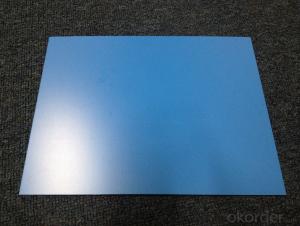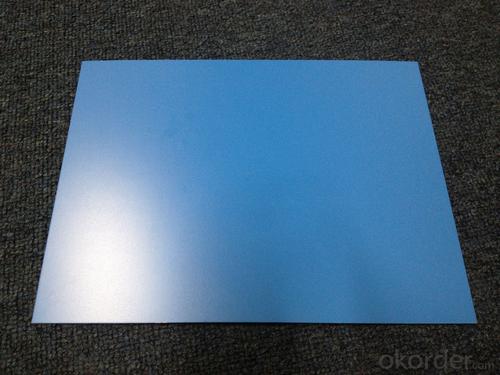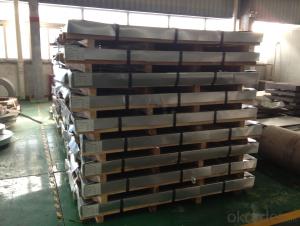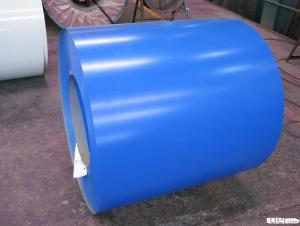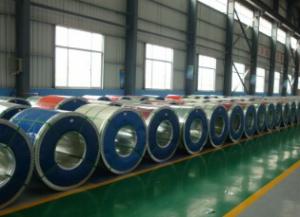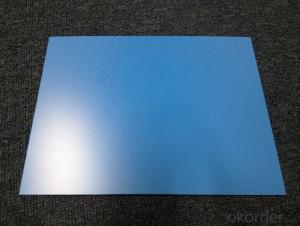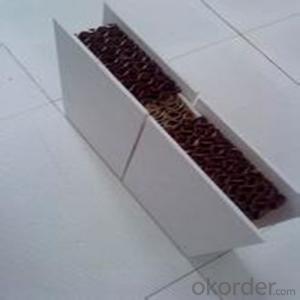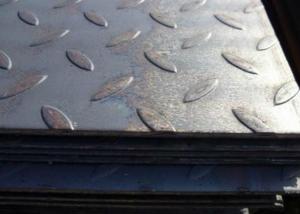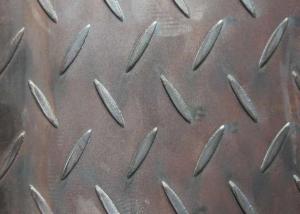PRE-PAINTED ALUZINC STEEL SHEET
- Loading Port:
- Tianjin
- Payment Terms:
- TT OR LC
- Min Order Qty:
- -
- Supply Capability:
- 8000 m.t./month
OKorder Service Pledge
Quality Product, Order Online Tracking, Timely Delivery
OKorder Financial Service
Credit Rating, Credit Services, Credit Purchasing
You Might Also Like
THICKNESS:0.18mm-1.5mm
WIDTH:900mm-1250mm
COATING MASS:AZ30-AZ180
PAINT:PE、HP、HDP、PVDF、SMP、MATT、PVDF
COLOR:RAL Scale
COIL INNER DIAMETER:508mm/610mm
COIL WEIGHT:3mt-7mt
BASE MATERIAL:Hot-dip Aluzinc Steel
- Q: Can steel sheets be used for staircase railings?
- Yes, steel sheets can be used for staircase railings. Steel is a durable and strong material that is commonly used in construction and engineering applications. Steel sheets can be fabricated into various shapes and designs to create stylish and modern staircase railings. They can be easily customized to suit different architectural styles and preferences. Additionally, steel railings are known for their longevity and low maintenance requirements, making them a popular choice for staircase installations.
- Q: How do steel sheets perform in terms of dimensional stability?
- Steel sheets are known for their excellent dimensional stability. This means that they are highly resistant to changes in size or shape when subjected to external forces or fluctuations in temperature. Steel is inherently strong and rigid, allowing it to maintain its shape and dimensions over extended periods of time. Additionally, steel sheets have low thermal expansion coefficients, meaning they expand and contract minimally with changes in temperature. This characteristic further enhances their dimensional stability, making them suitable for applications where precise dimensions and consistent performance are critical. Steel sheets are widely used in various industries, including construction, automotive, and manufacturing, due to their reliable dimensional stability.
- Q: What is the difference between plain carbon steel sheet and stainless steel sheet?
- Plain carbon steel sheet and stainless steel sheet are both types of steel sheets, but they exhibit several distinct dissimilarities. The primary contrast between plain carbon steel sheet and stainless steel sheet resides in their composition and characteristics. Plain carbon steel sheet consists predominantly of iron and carbon, with minor amounts of other elements like manganese and silicon. It is renowned for its strength and durability, rendering it suitable for a wide array of applications. However, plain carbon steel is susceptible to rust and corrosion when exposed to moisture or certain chemicals. Conversely, stainless steel sheet comprises iron, carbon, and a minimum of 10.5% chromium. This inclusion of chromium forms a protective layer on the steel's surface, referred to as a passive film, which prevents corrosion and rusting. Stainless steel manifests high resistance against stains, heat, and corrosion, making it an ideal choice for scenarios where hygiene and durability are pivotal, such as the food and medical industries. Another notable difference between the two steel sheet types lies in their appearance. Plain carbon steel sheet exhibits a mundane grey finish, whereas stainless steel sheet boasts a lustrous, reflective surface. This aesthetic distinction often holds significance in industries where the material's visual appeal is crucial, such as architectural or interior design applications. Furthermore, stainless steel sheet commands a higher price point compared to plain carbon steel sheet. This discrepancy arises due to the additional alloying elements, such as chromium and nickel, incorporated to enhance its corrosion resistance and other properties. The elevated cost of stainless steel is frequently justified by its superior performance and longevity in corrosive environments. To summarize, the key disparities between plain carbon steel sheet and stainless steel sheet encompass their composition, properties, appearance, and price. Plain carbon steel epitomizes strength but is prone to rust, while stainless steel epitomizes corrosion resistance and showcases a lustrous finish. The selection between the two hinges upon the specific requirements of the application, encompassing the necessity for corrosion resistance, aesthetics, and budget constraints.
- Q: What are the different sheet metal forming techniques for steel sheets?
- There are several different sheet metal forming techniques that can be used for steel sheets. These techniques are utilized to shape the metal into desired forms and structures. Some of the common sheet metal forming techniques for steel sheets include: 1. Bending: This is a widely used technique in which the sheet is bent to create angles, curves, or complex shapes. It can be done manually or by using machines such as press brakes. 2. Stretch forming: In this technique, the sheet is stretched and formed over a mold or die to create a desired shape. It is commonly used for large and curved components. 3. Deep drawing: This technique involves using a punch and a die to form a sheet metal into a desired shape. It is commonly used for creating cylindrical or box-like structures such as cans, pots, or automotive components. 4. Roll forming: Roll forming involves passing the sheet metal through a series of rollers to gradually shape it into a desired form. It is often used for producing long and continuous shapes such as rails, tubes, or channels. 5. Spinning: This technique involves rotating a sheet metal while shaping it against a mandrel using a spinning tool. It is commonly used for creating cylindrical or conical shapes such as lampshades or cookware. 6. Embossing: In this technique, the sheet metal is stamped with a pattern or design to create a raised or recessed surface. It is commonly used for decorative purposes or to improve the structural integrity of the sheet. 7. Hydroforming: Hydroforming utilizes hydraulic pressure to shape the sheet metal into complex forms. It is often used for creating automotive components such as car body panels or exhaust systems. These are just a few examples of the sheet metal forming techniques that can be used for steel sheets. The choice of technique depends on the desired shape, complexity, and requirements of the application.
- Q: Are the steel sheets suitable for electrical enclosures?
- Yes, steel sheets are suitable for electrical enclosures due to their durability, strength, and ability to provide protection against environmental elements and electromagnetic interference.
- Q: How are steel sheets protected during transportation by sea?
- To ensure the safety and prevent damage of steel sheets during transportation by sea, various measures are taken. One commonly used method involves applying a protective coating to the sheets. This coating acts as a barrier against moisture and saltwater, which are the main culprits behind corrosion during sea transportation. The coating can be a temporary solution, such as a layer of oil or wax, or a more permanent option, such as a layer of paint or zinc. Moreover, steel sheets are often bundled or placed in shipping containers for added protection. These bundles are secured with straps or wires to prevent movement and potential damage in rough sea conditions. The shipping containers themselves are designed to withstand the challenges of sea transportation and shield the steel sheets from exposure to the elements. Additionally, the sheets may be wrapped in plastic or other waterproof materials to provide an extra layer of defense against moisture. This helps prevent direct contact with seawater or rain, thus reducing the risk of corrosion. During the loading and unloading processes, proper handling techniques are employed to minimize the risk of damage. Cranes or forklifts are carefully used to lift and move the steel sheets, ensuring that they are not dropped or subjected to excessive force that could cause dents or bends. Overall, a combination of protective coatings, secure packaging, and proper handling techniques is utilized to safeguard steel sheets during sea transportation. This reduces the likelihood of damage and ensures that they reach their destination in optimal condition.
- Q: Are steel sheets resistant to warping and twisting?
- Yes, steel sheets are highly resistant to warping and twisting due to their inherent strength and rigidity properties.
- Q: What is the maximum size available for steel sheets?
- The maximum dimensions of steel sheets can differ based on the type and grade of steel used and the manufacturing capabilities of the supplier. Generally, steel sheets can be produced in sizes ranging from small sheets measuring a few inches in width and length, to large sheets measuring several feet or even meters in width and length. The transportation and handling restrictions can also affect the maximum size of steel sheets available, as larger sheets might be harder to transport and manipulate. To determine the maximum size of steel sheets that fit your specific needs, it is advisable to consult with a steel supplier.
- Q: What are the applications of steel sheets in construction?
- Steel sheets have a wide range of applications in construction due to their exceptional strength, durability, and versatility. Some of the key applications of steel sheets in construction include: 1. Roofing and cladding: Steel sheets are commonly used for roofing and cladding in both residential and commercial buildings. They provide a weather-resistant and long-lasting solution, protecting the structure from the elements. 2. Structural components: Steel sheets are utilized in the construction of structural components like beams, columns, and trusses. The high strength-to-weight ratio of steel allows for the creation of lightweight yet robust structures that can withstand heavy loads and seismic forces. 3. Flooring: Steel sheets are often used as flooring material in industrial buildings, warehouses, and factories. Their smooth surface makes it easy to clean and maintain, while their strength and fire-resistant properties provide a safe working environment. 4. Wall partitions: Steel sheets are commonly employed in the construction of wall partitions due to their stability and sound insulation properties. They can easily be cut and shaped to fit any design, allowing for flexible and customizable partition layouts. 5. Ductwork and HVAC systems: Steel sheets are widely used in the fabrication of ductwork and HVAC systems. Their smooth and airtight surfaces allow for efficient air movement and regulation, ensuring proper ventilation and temperature control in buildings. 6. Reinforcement: Steel sheets are often integrated into concrete structures as reinforcement. This helps to enhance the strength and load-bearing capacity of the building, making it more resistant to bending, tension, and compression forces. 7. Safety and security: Steel sheets are utilized in the construction of safety and security features such as doors, gates, and window frames. Their high strength and resistance to impact and vandalism make them an ideal choice for ensuring the safety and protection of a building. In summary, steel sheets are extensively used in construction for roofing, cladding, structural components, flooring, wall partitions, ductwork, reinforcement, and safety features. Their superior strength, durability, and versatility make them an essential component in various construction applications, contributing to the overall safety, longevity, and functionality of buildings.
- Q: What is the process of cutting steel sheets?
- The process of cutting steel sheets typically involves using specialized tools or machinery such as shears, laser cutters, or plasma cutters to accurately and precisely cut through the steel material. This process may involve marking the desired cut lines, securing the sheet, and then applying the cutting method to achieve the desired shape or size. Safety measures like wearing protective gear and ensuring proper ventilation are necessary during the cutting process.
Send your message to us
PRE-PAINTED ALUZINC STEEL SHEET
- Loading Port:
- Tianjin
- Payment Terms:
- TT OR LC
- Min Order Qty:
- -
- Supply Capability:
- 8000 m.t./month
OKorder Service Pledge
Quality Product, Order Online Tracking, Timely Delivery
OKorder Financial Service
Credit Rating, Credit Services, Credit Purchasing
Similar products
Hot products
Hot Searches
Related keywords
